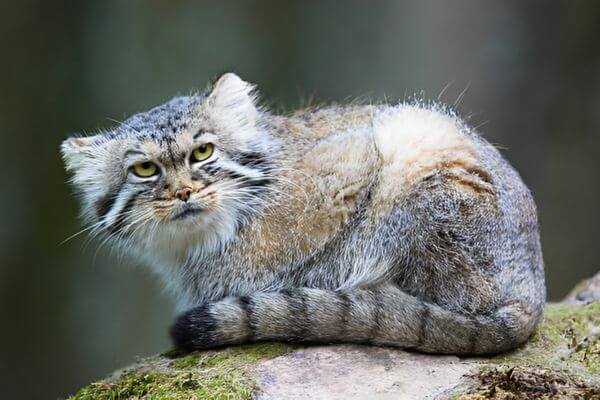In the vast and diverse universe of felines, one member that stands out is the Pallas’ Cat, not only for its rare beauty, but also for its unusual behavior and habitat. Inhabiting the high and cold regions of Central Asia, this enigmatic feline has defied understanding and captured the imagination of many. Dive with us on the journey of discovering the secrets of this cat, exploring everything from its unique biological characteristics to the myths that surround it and the ongoing efforts to protect this treasure of nature.

Diving into the Hidden World of Pallas Cats
Pallas cats are also known as Manuls, Steppe Cat, Highland Cat, Central Asian Cat and finally as Mountain Cat. They are fascinating and enigmatic felines that inhabit the mountainous regions of Central Asia. With their dense coat, expressive eyes, and a face that seems perpetually surprised, these cats have a distinctive appearance that sets them apart from other felines. Adapted to the arid and cold environments of the high plateaus, they have developed unique characteristics, such as a slow metabolism and more robust lungs, that allow them to survive at altitudes of up to 5,000 meters.
The uniqueness of this feline is not just limited to its appearance. They have a distinct behavior, being solitary and territorial creatures. Unlike other wild cats, Pallas tend to be more diurnal, hunting small mammals and birds during the day. Their elusive nature and preference for remote habitats make them a rare sight, adding to the mystery and fascination surrounding these beautiful animals.
The Hidden Habitat: The Remote Regions Where the Pallas Cat Resides
In the vast and inhospitable landscapes of Central Asia, between rocky mountains and cold steppes, we find the secret kingdom of the Manul Cat. These lands, which stretch from northern India to Mongolia and parts of China, are home to an environment that few animals could call home. The conditions are extreme, with drastically low temperatures and thin air, but it is precisely here that the Pallas Cat has found its niche, evolving over the years to face such challenges. Its thick fur serves as thermal insulation, and its large lungs absorb the scarce oxygen of the high plateaus.
But even in this challenging habitat, they share their territory with other animals adapted to cold climates, such as the Tibetan antelope and the steppe wolf. To remain discreet and avoid predators, the Planalto Felino has developed a coat that resembles the color of rocks and dry vegetation, allowing them to blend in seamlessly with their surroundings. This camouflage ability, combined with its reclusive nature, makes it one of the most enigmatic and rarely seen felines in its natural habitat.
Rarity Explained: Environmental Factors and Threats to Survival
The rarity of the Pallas Cat is not merely a consequence of its choice of remote and inhospitable habitats. Instead, it is the result of a combination of environmental challenges and external threats. Being a specialized animal, it had to evolve to survive in very specific conditions, making it particularly vulnerable to changes in its environment. Habitat degradation, driven by human development and climate change, has reduced the space available to these cats, limiting their resources and increasing competition for food.
In addition to environmental pressures, they also face direct threats from hunters and herders. In some regions, they are hunted for their unique coat, while in others, they are seen as threats to livestock and consequently slaughtered. The combination of these threats, along with its low population density and reproduction rate, places the Pallas Cat in a precarious position. To ensure the survival of this enigmatic feline, it is essential to understand and address these threats by promoting targeted conservation efforts and educating local communities about the importance of this animal.
Unique Posture: The Biology Behind Standing Pallas Cats
The standing behavior is one of the most intriguing characteristics of the Manul Cat, generating a lot of curiosity and speculation. Unlike the traditional four-legged posture adopted by most felines, the Highlands Feline is occasionally observed rearing up on its hind legs, similar to small rodents or meerkats, especially when they are curious or alert. This posture, it seems, allows them to obtain an expanded view of their surroundings, facilitating the identification of potential threats or prey amid the undergrowth of the high plateaus.
From a biological perspective, this ability to stand is supported by a combination of strong hind leg muscles and keen balance. It is also possible that evolution has favored this posture in environments where visibility is crucial, both to hunt and to avoid being hunted. Thus, this posture is not just a charming peculiarity, but an evolutionary adaptation that aids Pallas’s Cat in its survival in the challenging landscapes where it lives.
Comparing to Other Felines: What Makes Pallas Cats So Different?
When we look at the vast world of cats, from the majestic lions of the African savannas to the agile snow leopards of the Himalayas, it is easy to see that each species has its own peculiarities. However, Pallas Cats stand out, even among this impressive diversity. The first thing many notice is this feline’s distinctive appearance: with its thick fur and round, piercing eyes, this feline looks like a hybrid between a fluffy domestic cat and a wild feline.
But it’s not just the appearance that sets it apart. Their behavior and biology are also unique. For example, unlike many other felines that purr continuously, the Pallas Cat has an intermittent purr, which is interspersed with pauses. Additionally, its adaptation to extreme cold and high altitudes has given it larger lungs and a slower metabolism compared to other cats. And of course, as mentioned previously, their occasional tendency to rear up on their hind legs adds another degree of distinction. These and other characteristics make the Pallas Cat a fascinating species, clearly differentiated in a world already full of notable felines.
Conservation Efforts: What’s Being Done to Protect This Enigmatic Feline
Growing awareness of the uniqueness and vulnerability of the Pallas Cat has driven a number of conservation efforts at local, national and international levels. Firstly, many countries within the Pallas Cat’s range have legislated protections for this species. This prohibits hunting and trading in their fur, combating one of the direct threats they face. Through these legal measures, there is also a stimulus for the protection of habitats and the creation of conservation areas that respect the natural environment of this feline.
Non-governmental organizations and conservation groups also play a crucial role in protecting Pallas Cats. These groups often conduct research to better understand the species’ ecology and behavior, informing effective conservation strategies. Furthermore, awareness and education programs with local communities are essential. These efforts seek to transform former threats, such as herders and hunters, into conservation allies, promoting peaceful coexistence and recognition of the intrinsic value of this unique creature. While challenges persist, the joining of forces for the conservation of the Pallas Cat is a hopeful sign for the future of this mysterious feline.
The Preservation of a Natural Treasure
Throughout this exploration of Pallas’s Cat, we are reminded of the vast and incredible tapestry of life that our planet is home to. This feline, with its unique features and distinctive behavior, is not only an example of the power of evolution, but also an emblem of nature’s fragility in the face of human change and threats. Its conservation is not just a matter of protecting a species, but of respecting and valuing the rich biodiversity of our world. By understanding and valuing creatures like the Pallas Cat, we reaffirm our commitment to a healthy and diverse planet for future generations.

